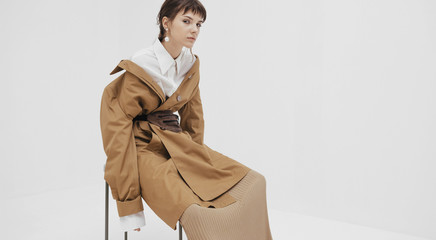Fashion is more than just clothing—it is a form of self-expression, a reflection of culture, and a statement of individuality. From the colors we choose to the cuts we prefer, fashion allows people to convey their personalities, moods, and creativity without saying a word. It is an ever-evolving art form that influences how we perceive ourselves and how others perceive us. Understanding fashion goes beyond trends; it involves embracing style, innovation, and the confidence that comes with wearing the right pieces.

One of the most exciting aspects of fashion is its constant evolution. Each season brings new ideas, materials, and aesthetics, allowing people to explore different styles and reinvent their wardrobes. While some trends are bold and experimental, others focus on timeless elegance and classic design. This cyclical nature of fashion ensures that there is always something fresh to discover, while also celebrating enduring pieces that have stood the test of time. The interplay between contemporary trends and classic styles provides endless opportunities for personal expression.
Color plays a crucial role in fashion, influencing both appearance and emotion. Vibrant colors can evoke energy, confidence, and creativity, while muted tones often convey sophistication, calmness, or minimalism. Understanding how to combine colors, patterns, and textures can elevate a simple outfit into a striking ensemble. Fashion enthusiasts experiment with complementary and contrasting colors to create visual interest, while also considering how certain shades enhance skin tone, hair color, and personal style. Color theory is an essential tool for anyone seeking to make a deliberate and stylish statement.
Texture and fabric are equally important in defining fashion choices. Materials such as silk, cotton, linen, and wool each offer unique qualities, including comfort, durability, and aesthetic appeal. Mixing textures can add depth and dimension to an outfit, making it more visually appealing and dynamic. For example, pairing a soft, flowing fabric with a structured piece creates contrast that draws attention and highlights the wearer’s sense of style. Fashion is not only about what we wear but also about how fabrics feel, move, and interact with the body.
Accessories are another key element that can transform an outfit. Items such as scarves, hats, belts, jewelry, and bags allow individuals to personalize their looks and express creativity. The right accessory can add a pop of color, create visual balance, or make a bold statement. Accessories also provide practical functionality while enhancing aesthetic appeal. Mastering the art of accessorizing enables fashion enthusiasts to take even the simplest ensemble to new heights, demonstrating attention to detail and an understanding of style dynamics.
Footwear is a fundamental component of fashion that blends style and functionality. Shoes not only complete an outfit but also influence posture, comfort, and movement. From casual sneakers to elegant heels or practical boots, footwear choices can define the overall mood and impression of a look. Fashion-forward individuals recognize that shoes are more than functional necessities; they are statement pieces that can complement, contrast, or elevate any outfit. Selecting the right footwear is often the final touch that transforms an ensemble into a cohesive, stylish presentation.
Sustainable fashion has gained significant attention in recent years, emphasizing ethical practices and environmentally conscious choices. Sustainable fashion encourages the use of eco-friendly materials, responsible production methods, and mindful consumption. Choosing timeless, high-quality pieces over fast fashion allows individuals to create versatile wardrobes that reduce waste and environmental impact. This approach highlights the importance of fashion as a tool not only for self-expression but also for promoting values and contributing to a healthier planet. Consumers increasingly prioritize brands and styles that align with sustainability principles, making conscious fashion choices a reflection of both taste and responsibility.
Fashion also serves as a cultural and social indicator. Clothing often reflects societal values, traditions, and historical context. Cultural influences can inspire unique designs, patterns, and accessories, offering insight into diverse perspectives and lifestyles. Fashion allows people to connect with cultural heritage, reinterpret traditional garments, and celebrate diversity in modern settings. By embracing cultural influences, individuals can create looks that are both stylish and meaningful, bridging the gap between past and present while honoring artistry and craftsmanship.
Personal style is an essential aspect of fashion that goes beyond following trends. While trends inspire, true style comes from understanding what suits one’s body shape, personality, and lifestyle. Developing a personal style requires experimentation, confidence, and a willingness to embrace individuality. Fashion enthusiasts often mix classic pieces with contemporary elements, creating a signature look that feels authentic and expressive. Personal style empowers individuals to communicate who they are through clothing, demonstrating creativity, confidence, and a unique perspective on aesthetics.
Fashion is also an influential form of storytelling. The way people dress can convey moods, intentions, and messages without the need for words. From professional attire that communicates competence to casual outfits that express comfort and creativity, clothing choices often shape how individuals are perceived in social and professional settings. Fashion allows people to craft a visual narrative that reflects personal experiences, values, and aspirations, giving them the power to leave lasting impressions.
In conclusion, fashion is a multifaceted world that combines art, culture, and personal expression. It offers endless opportunities to explore creativity, enhance self-confidence, and communicate individuality. From color, texture, and accessories to footwear, sustainable choices, and personal style, every element contributes to the overall impact of an outfit. Fashion is not merely about clothing—it is about feeling empowered, making intentional choices, and celebrating uniqueness. Embracing fashion allows individuals to present themselves authentically, connect with cultural and social influences, and enjoy the transformative power of style in everyday life.